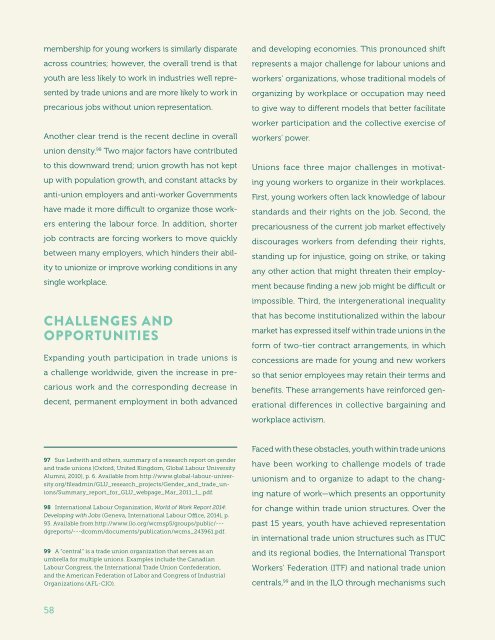YOUTH CIVIC
JieguI2U
JieguI2U
You also want an ePaper? Increase the reach of your titles
YUMPU automatically turns print PDFs into web optimized ePapers that Google loves.
membership for young workers is similarly disparate<br />
across countries; however, the overall trend is that<br />
youth are less likely to work in industries well represented<br />
by trade unions and are more likely to work in<br />
precarious jobs without union representation.<br />
Another clear trend is the recent decline in overall<br />
union density. 98 Two major factors have contributed<br />
to this downward trend; union growth has not kept<br />
up with population growth, and constant attacks by<br />
anti-union employers and anti-worker Governments<br />
have made it more difficult to organize those workers<br />
entering the labour force. In addition, shorter<br />
job contracts are forcing workers to move quickly<br />
between many employers, which hinders their ability<br />
to unionize or improve working conditions in any<br />
single workplace.<br />
CHALLENGES AND<br />
OPPORTUNITIES<br />
Expanding youth participation in trade unions is<br />
a challenge worldwide, given the increase in precarious<br />
work and the corresponding decrease in<br />
decent, permanent employment in both advanced<br />
and developing economies. This pronounced shift<br />
represents a major challenge for labour unions and<br />
workers’ organizations, whose traditional models of<br />
organizing by workplace or occupation may need<br />
to give way to different models that better facilitate<br />
worker participation and the collective exercise of<br />
workers’ power.<br />
Unions face three major challenges in motivating<br />
young workers to organize in their workplaces.<br />
First, young workers often lack knowledge of labour<br />
standards and their rights on the job. Second, the<br />
precariousness of the current job market effectively<br />
discourages workers from defending their rights,<br />
standing up for injustice, going on strike, or taking<br />
any other action that might threaten their employment<br />
because finding a new job might be difficult or<br />
impossible. Third, the intergenerational inequality<br />
that has become institutionalized within the labour<br />
market has expressed itself within trade unions in the<br />
form of two-tier contract arrangements, in which<br />
concessions are made for young and new workers<br />
so that senior employees may retain their terms and<br />
benefits. These arrangements have reinforced generational<br />
differences in collective bargaining and<br />
workplace activism.<br />
97 Sue Ledwith and others, summary of a research report on gender<br />
and trade unions (Oxford, United Kingdom, Global Labour University<br />
Alumni, 2010), p. 6. Available from http://www.global-labour-university.org/fileadmin/GLU_research_projects/Gender_and_trade_unions/Summary_report_for_GLU_webpage_Mar_2011_1_.pdf.<br />
98 International Labour Organization, World of Work Report 2014:<br />
Developing with Jobs (Geneva, International Labour Office, 2014), p.<br />
93. Available from http://www.ilo.org/wcmsp5/groups/public/---<br />
dgreports/---dcomm/documents/publication/wcms_243961.pdf.<br />
99 A “central” is a trade union organization that serves as an<br />
umbrella for multiple unions. Examples include the Canadian<br />
Labour Congress, the International Trade Union Confederation,<br />
and the American Federation of Labor and Congress of Industrial<br />
Organizations (AFL-CIO).<br />
Faced with these obstacles, youth within trade unions<br />
have been working to challenge models of trade<br />
unionism and to organize to adapt to the changing<br />
nature of work—which presents an opportunity<br />
for change within trade union structures. Over the<br />
past 15 years, youth have achieved representation<br />
in international trade union structures such as ITUC<br />
and its regional bodies, the International Transport<br />
Workers’ Federation (ITF) and national trade union<br />
centrals, 99 and in the ILO through mechanisms such<br />
58


